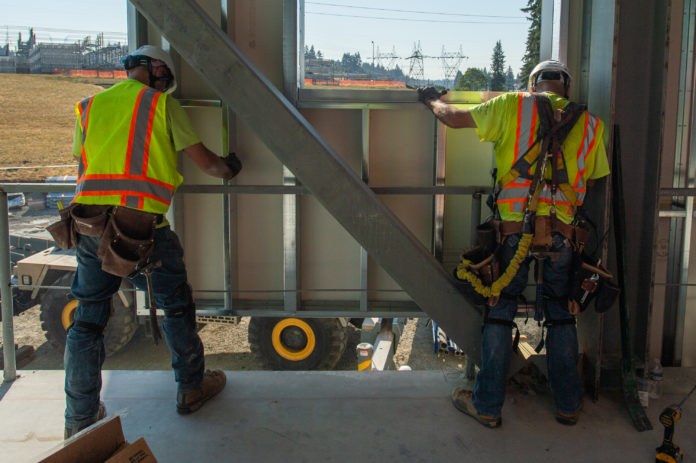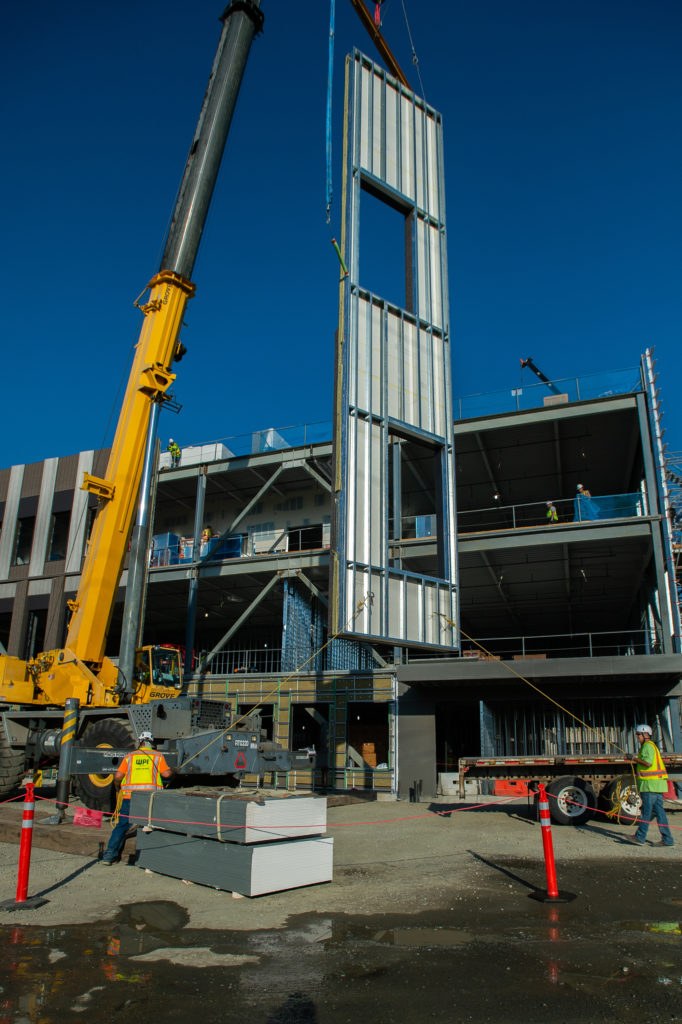
Mortenson, a leading developer and design-builder in Oregon, along with Portland-based Opsis Architecture, California-based DGA Architects, and Wilsonville-based contractor and fabricator Western Partitions, Inc., (which also has a facility for their manufacturing operations at the Port of Vancouver USA) completed installation in late October of a prefabricated building enclosure system on the Bonneville Power Administration (BPA) Ross Complex Technical Services Building in Vancouver, according to a news release from Mortenson. The progressive design-build project delivery method being used for the project streamlined the use of prefabrication, reduced two months from the construction timeline and gleaned a savings of more than $1 million on the overall budget.
According to BPA, the new facility will help avoid $25 million in upgrades to the old buildings it’s replacing and help save hundreds of thousands of dollars per year in avoided lease costs. A critical component of BPA’s operations, the Technical Services Building will support maintenance, testing and repair to maintain modern electronic transmission communications and controls. The Technical Services Building project is scheduled for completion the summer of 2023, according to the news release.
While prefabrication is not a new solution for efficiency in commercial construction, the use of prefabricated panels on a building exterior is still quite rare. The key to the successful use of prefabrication for the Technical Services Building is the progressive design-build delivery method being used to construct this building. Heralded by the Design-Build Institute of America, this method prescribes that the design-builder is selected by the owner early in the project and primarily for their qualifications. As with all progressive design-build projects, the Technical Services Building is being delivered in two distinct phases: design development and pre-construction, and final design and construction.
“Progressive design-build delivery lends to the use of prefabrication and its related benefits, including the early selection of materials and associated cost efficiencies. We consider the Technical Services Building project a template for progressive design-build teams seeking to optimize value and design of a whole project from the beginning through to project delivery,” said Trent Rehfeldt, Mortenson market executive, in the news release. “Prefabrication is also a creative approach for offsetting increasing materials costs and the craft worker labor shortage the construction industry is facing.”

As part of the pre-construction planning process, the design-build team explored ways for maximizing their respective strengths to provide the greatest value possible, resulting in an early decision to use prefabrication. After evaluating seven types of enclosure systems, the team opted to leverage Western Partition’s ability to fabricate the façade panels at its facility less than 10 miles from the project site.
“This project brought unique challenges that we haven’t had to address before,” said Kim Lindman, Western Partitions, Inc., project manager, in the news release. “It changed our approach to be able to maximize the architectural design we were seeking. That’s the fun part of prefab – stepping out of the box and figuring out how we’re going to make it work.”
Each panel of the Ross Complex Technical Services Building project is unique. There are a series of ground floor panels that cover the first level of the building. Then a series of two-story panels up to 42 feet tall enclose the upper floors of the three-story structure. Each of these panels feature metal stud frame assembly with Swiss pearl fiber cement panels and articulated metal panels with ribs. Only specific areas were conventionally framed on the project, such as under and within structural steel canopies.
“Innovative use of prefabricated panels supported our overall design philosophy for the Technical Services Building.” said Paul Kinley, Opsis Architecture, in the news release. “Our design used the color, depth, texture and pattern of the metal panel cladding to give the building a unique personality, one that responds beautifully to daily and seasonal changes in daylight. The ability to vary the application of pattern also helped express the organization of internal program areas and help communicate the mission of this important building.”
Mortenson has used prefabricated components in its projects since 2012, the most prominent example being Saint Joseph Hospital in Denver, a project that incorporated prefabricated headwalls, prefabricated bathroom pods, exterior panels and multi-trade racks. According to Rehfeldt, “the focus is always on improving the customer’s experience.”


